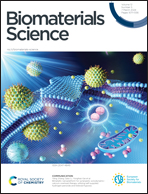Biomimetic triphasic silk fibroin scaffolds seeded with tendon-derived stem cells for tendon-bone junction regeneration†
Abstract
The regeneration of tendon and bone junctions (TBJs), a fibrocartilage transition zone between tendons and bones, is a challenge due to the special triphasic structure. In our study, a silk fibroin (SF)-based triphasic scaffold consisting of aligned type I collagen (Col I), transforming growth factor β (TGF-β), and hydroxyapatite (HA) was fabricated to mimic the compositional gradient feature of the native tendon-bone architecture. Rat tendon-derived stem cells (rTDSCs) were loaded on the triphasic SF scaffold, and the high cell viability suggested that the scaffold presents good biocompatibility. Meanwhile, increased expressions of tenogenic-, chondrogenic-, and osteogenic-related genes in the TBJs were observed. The in vivo studies of the rTDSC-seeded scaffold in a rat TBJ rupture model showed tendon tissue regeneration with a clear transition zone within 8 weeks of implantation. These results indicated that the biomimetic triphasic SF scaffolds seeded with rTDSCs have great potential to be applied in TBJ regeneration.



 Please wait while we load your content...
Please wait while we load your content...